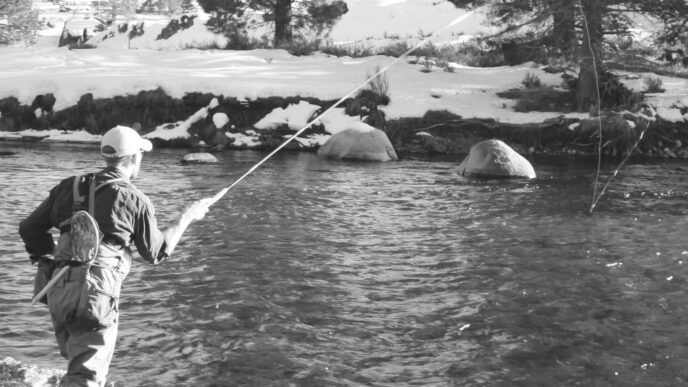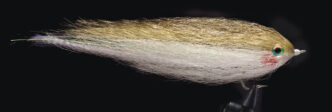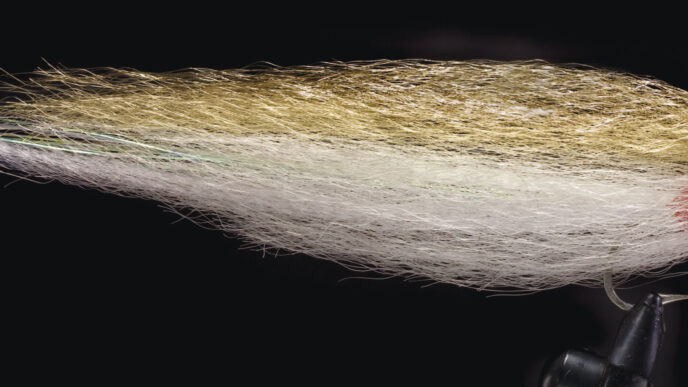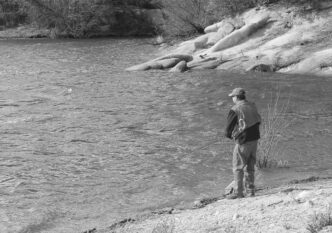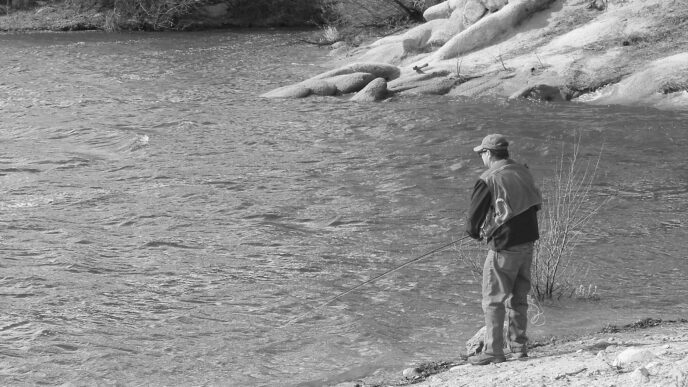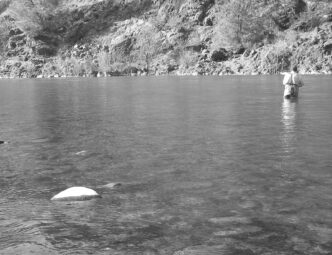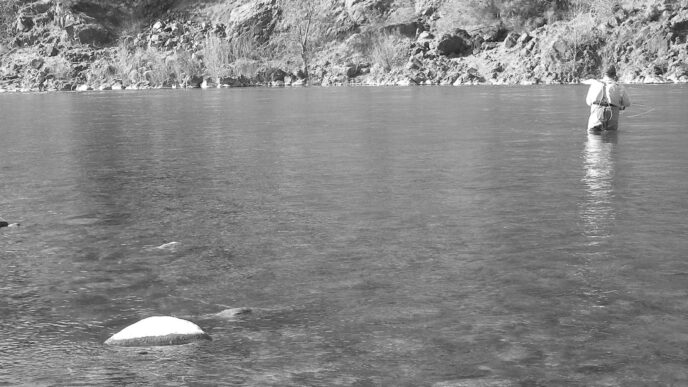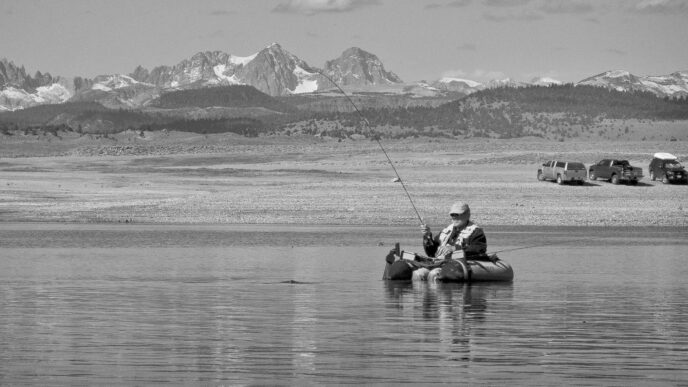Next to rods, reels, and lines, waders and associated wading gear probably constitute an angler’s most significant equipment purchase. Over the past 40 or so years, waders have consistently improved as manufacturers moved from rubber and rubberized canvas to waterproof nylon and neoprene and, for the past decade, to one form of breathable/waterproof fabric or the other. Wading boots recently have undergone changes to respond to the threats posed by the transportation of invasive species, and there have been developments and tweaks in wading clothing, vests, packs, and other luggage, and other gear you supposedly just can’t do without, either on the stream or going to and from it.
Waders
Innovators at companies such as Simms, Patagonia, and Orvis have led the way in consistently improving their waders, with better fabrics, integral gravel guards, articulated legs, high-density bootie materials that don’t leak after hard use, booties with ergonomic shapes and seams placed so as not to cause blisters, external pockets and handwarmers, and for the past few years, breathable waders with reliable waterproof zippers. For 2011, there are a handful of new waders worth checking out.
Orvis made news in late 2009 with their lightweight SonicSeam Pack and Travel waders and wading pants. These waders joined fabric sections sonically, instead of sewing them, overtaping the seams only for abrasion resistance. With no stitch holes that could ultimately leak and with no fabric overlap for seams, the waders were substantially less bulky and packed down to a very small package: great for, among other things, airline travel. For 2011, Redington has used sonic welding technology (presumably under license to Orvis, who holds a patent on it) and introduced two Sonic Pro wader models and a Sonic Pro wading pant. Where Orvis went for light weight and lack of bulk, Redington has gone more mainstream, producing attractive, substantial-looking waders that use five-layer fabric on the lower leg and seat, three-layer fabric in the uppers, and double-taped seams. The basic Sonic Pro stockingfoot model ($249.95) has lots of features: articulated legs, integral gravel guards with lace hooks, fleece-lined handwarmer pockets, exterior pockets, and a hemostat-clamp D-ring. The Zip Front model ($349.95) has all that plus a full, center-front waterproof zipper. The lighter-weight Sonic Pro wading pants ($199.95) are of three-layer fabric throughout, have two front pockets with water-resistant zippers, and removable suspenders.

Another interesting wader development for 2011 is Patagonia’s new Rio Gallego model, which now tops the company’s wader line. (Guidewater and Watermaster models have been updated and remain in the line.) The Rio Gallego ($449) uses the merino-wool-lined neoprene bootie that Patagonia introduced a year ago. The shallow miniature cornrows of wool inside the bootie are there to moderate the temperature and to provide both warmth and wicking without adding bulk. Friends who’ve tried them say they work. Seams on the waders’ articulated thigh areas have been moved toward the front and armored with external tape to minimize potential wear. There’s a waterproof inner pocket, an exterior front pocket, and removable neoprene knee pads. The legs and seat have three-layer fabric, with a lighter fabric above. Patagonia has also improved it’s shoulder-strap suspension system, which attaches at the waist, inside the wader, rather than at the top seam. Reports on the older version of this system, which used a button to secure the wader top to the strap, had been mixed. Some users liked the easy conversion to waist-highs, but a couple of hard-fishing anglers told me the button was useless and that they hated the way the top of the wader flapped around. For 2011, Patagonia has done away with the button and replaced it with a neat sliding lock along the strap. Should be lots better.
L. L. Bean has what looks to be a winner for the ladies among us with their new Women’s Emerger Stocking-Foot Waders. Priced very reasonably at $109, they’re not only waterproof, breathable, with built-in gravel guards for the neoprene feet, double-layer articulated knees, and quick-release buckles on the shoulder straps, but they’re cut for the feminine figure.
Hendrix Outdoors of Fallon, Nevada, has been around for 40 years, originally as
a distributor of fly-fishing tackle and since 2002 as a manufacturer/designer. Flying largely under the radar, they’ve nonetheless managed to establish a strong national dealer presence, and over a dozen California fly shops carry some of their products. For 2011, Hendrix has introduced two new breathable waders, the Guide Weld chest-high wader ($299.95) and a waist-high called the Green River ($219.95). Both of these products share the same premium microfiber fabric and high-grade waterproof/breathable membrane. Both have double-articulated knees, five layers of fabric at the knee and seat, attached gravel guards, and four-millimeter neoprene feet. The Guide Welds also have welded-seam, microfleece-lined handwarmer pockets and a storage pocket. They’re worth a look.
Wading Boots
There’s more activity in the boot category for 2011 than for waders themselves, no doubt in part because everyone’s trying to come up with designs that minimize a boot’s potential for being a host to invasive species.
Korkers won a Dealers’ Choice award at the 2010 Fly Tackle Dealer Expo for their new Chrome-brand wading boots ($179.99). To keep weight down, these boots are made entirely from hydrophobic materials, with drainage ports set low in the midsole to channel water out of the boot. They feature a seamless toe guard, an updated version of the OmniTrax interchangeable sole system (version 3.0), and a new version of the crank-up Boa metal lace-adjustment system that’s lower in profile and quite a bit faster than the previous one. Chrome boots generally come with both Klingon sticky rubber soles and felt soles, but three other interchangeable soles are also available: standard rubber with carbide spikes, Klingon sticky rubber with carbide spikes, and felt with carbide spikes, for an additional charge of $30 to $40 per sole.
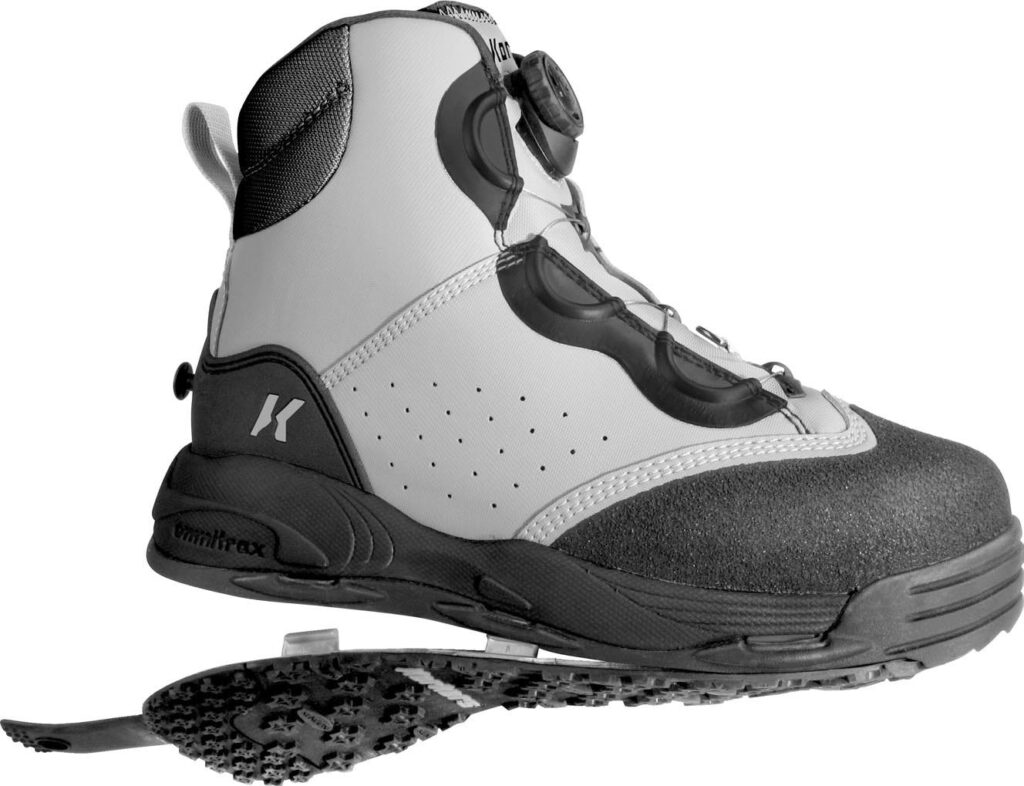
Orvis has three new wading boots for 2011. First, they worked with Korkers to add the OmniTrax interchangeable sole system to Orvis River Guard boots. This is the previous version of OmniTrax, as opposed to the version 3.0 that Korkers is using on its new Chrome boots, but it’s still darn good. Orvis’s Korkers Interchangeable Riverguard Ultralight Boots ($225) come out of the box fitted with the Orvis EcoTraX outsoles, but all the other OmniTrax 2.0 soles will fit.
Orvis’s redesigned entry-level Streamline wading boots come soles either of felt ($69) or of studded rubber ($98) and feature uppers of a durable new high-density nylon, a neoprene collar at the top, and webbing lacing eyelets. There’s also a new Orvis Clearwater II Wading Boot, a sturdy, lightweight boot with over-the-ankle height. It’s offered in felt ($98) that will accept Orvis’s PosiGrip studs ($29.95), or in EcoTraX studded sticky rubber ($169).
Last year, Redington introduced a wading boot with a sticky rubber sole that was “siped” with multiple razor-thin cuts designed to open and grip the bottom. For 2011, in addition to an updated version of that boot (renamed the Elwha River Boot, $129.95), Redington innovation continues with two new boots whose soles combine sticky rubber with crushed walnut shells (!) for added traction. The Skagit River ($99.95 with rubber/walnut; $89.95 with plain felt) is for men, and the Willow River version (same prices) is built for women. Whipped cream and maraschino cherries are presumably optional.
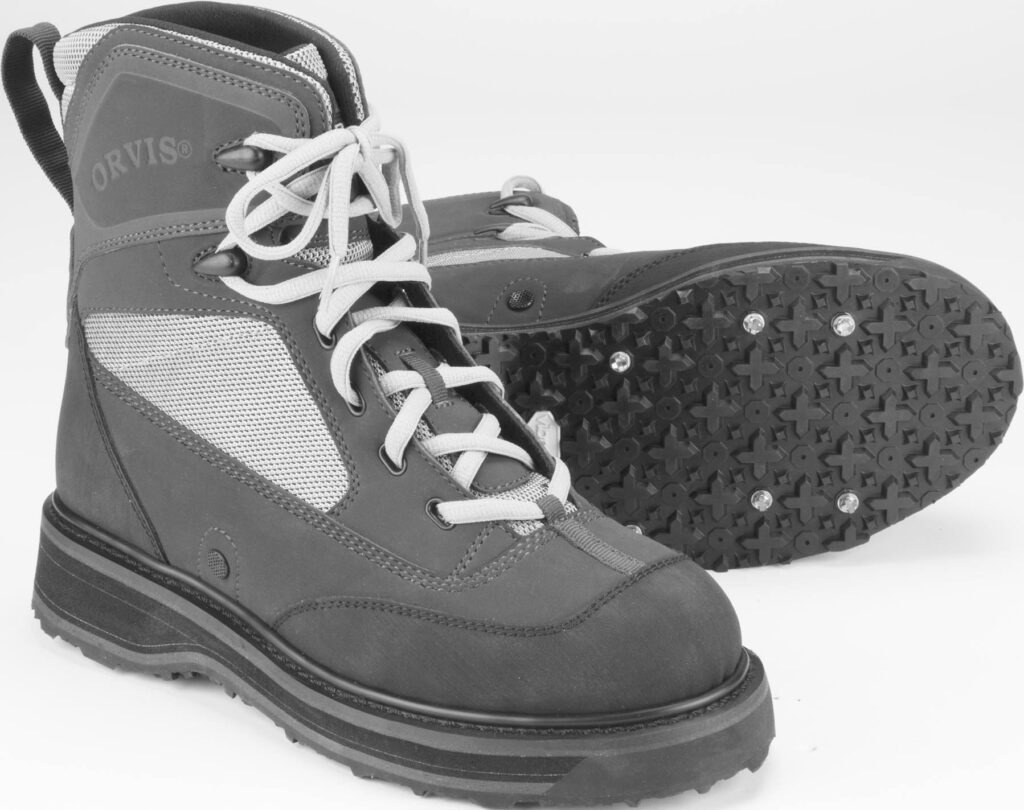
Patagonia’s Rock Grip Wading Boot ($179) is another neat new offering. Billed as “the most durable and high-performance wading shoe on the market,” it features a stitchless design, a compression-molded EVA midsole, proprietary sticky rubber soles with an aggressive tread pattern that accepts supplied removable studs, and stainless steel lacing loops.
Simms has two new footwear items for days when you want to wade wet. The RipRap Shoe ($99.95) is essentially a running shoe with a Simms StreamTread sole that laces up a bit higher on the ankle for a good seal against gravel. And the new StreamTread Sandals are just that . . . they look like a pair of Keens with the StreamTread sole. Both accept all of Simms’s stud options: HardBite Studs ($29.95), the more aggressive HardBite Star Cleats ($39.95), and the new AlumiBite Cleat ($29.95).
Clothing
On the wading-jacket front, Redington and Simms have both introduced waterproof and breathable models designed and cut for women. Redington’s Deschutes Rain Jacket ($149.95) is made from a fully seam-sealed four-way-stretch fabric and has an internal chest pocket with zip closure and an adjustable hood with a brim. It’s available in moss green and kingfisher blue/green.
Simms’s new Women’s Guide Jacket ($299.95) is made from Gore-Tex Soft Shell, with concealed vertical chest pockets, flannel-lined zippered handwarmer pockets, and a lightweight hood that stows in the high collar — very sleek and attractive in a color Simms calls “gunmetal.”
For men, Simms has redesigned their ultralightweight waterproof/breathable Paclite Jacket. It’s a bit shorter, has a higher collar for more neck protection, and no longer has the two zip-closed pockets. And for those of you who can’t fish in the rain without your tunes, its large chest pocket features an audio-cable routing system for on-the-go music. At $199.95, it also costs $50 less than last year’s version. In smoke blue and gunmetal.
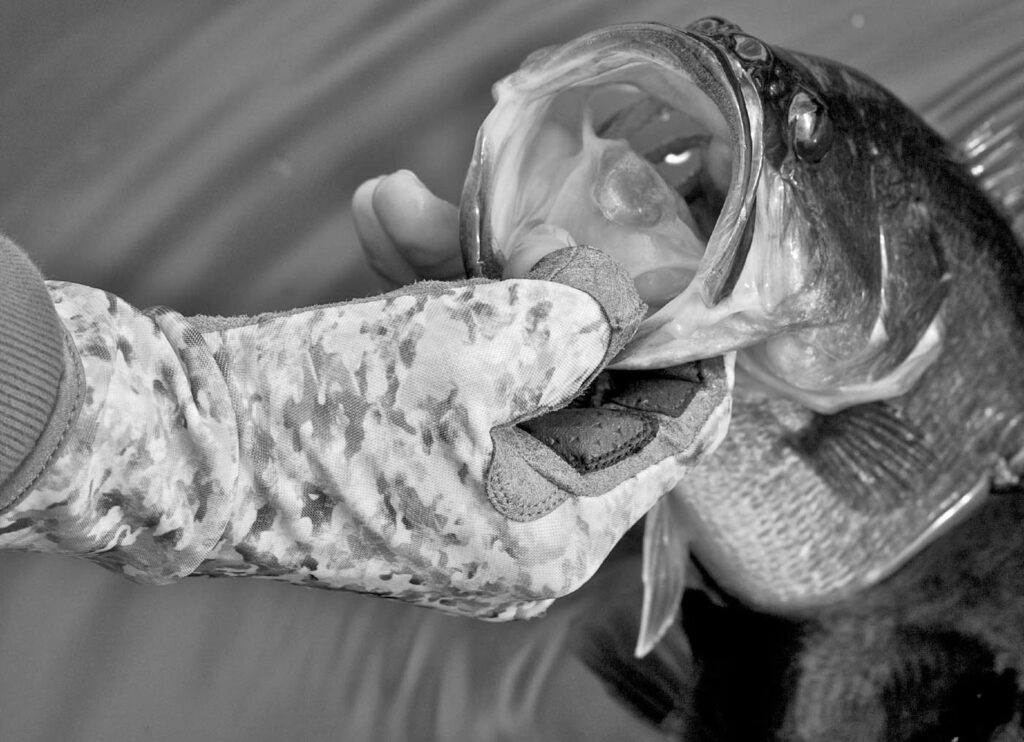
Anglers who fish when it’s cold will be happy to discover that Simms has reintroduced the Guide Fleece Bibs ($119) that they discontinued in 2008. Think of this as a sleeveless union suit in a mediumweight four-way-stretch fleece with a zipper up the front and two zippered chest pockets. You might not want to hike much while wearing these bibs, but for less spirited cold-weather angling activity or for sitting in a drift boat when the frost is on the pumpkin, they’re great.
Also for the cold-weather angler, Patagonia has introduced R-1 Gloves ($39). Made from smooth-skin neoprene and polypropylene, they are light and, as the Patagonia folks say, “offer up a toasty waterproof solution” to fishing when the temperature drops. And not to be outdone by the folks at Buff, whose ubiquitous UVand-wind-fighting microfiber head/neck scarves, printed in about a thousand colors and patterns, now grace the necks and faces of countless anglers, Patagonia has logged on with their own version. Rather simply named the Printed Sun Mask ($25), it’s available in two fish-themed prints: Tarpon Face and Rainbow Face (honestly). Buff, meanwhile, has come up with its own line of sun-protection Angler Gloves ($40) in four colors: gray, fish camo, skoolin azul, and, in a move that’s sure to delight the folks up in Bainbridge, Washington, skoolin sage. Be the first in your posse. . . .
The new Bone Flats shirts ($74) from Railriders are made from attractive, 1.5-ounce Duralite nylon fabrics that feature a flip-up sun collar, two zippered vertical entry chest pockets, and along with the usual back vent, mesh panels running down the inside of the arms and the outside of the torso. They’re matched with Bone Flat Pants ($89) of the same light fabric, with articulated knees, a removable belt, reinforced pocket seams (two front pockets, one zippered back pocket), and mesh panels that run down the outside of the legs from the upper thigh to three or four inches above the bottom seam. Both shirt and pants offer UPF 30+ protection from the sun’s rays.
Fishing Packs and Luggage
Fishpond and Orvis have both been busy on new vest/pack/luggage designs. For Orvis, that’s meant not only bringing out more than a score of new or updated soft-good products, but a tectonic shift away from the conservative olives and tan hues that have colored its soft goods for decades. The resulting new line of products, in bright blue or red, accented with gray, includes waist packs, a sling pack, duffels, rolling duffels, day packs, chest packs, a fly-box organizer, fly-reel cases, and the inevitable laptop briefcase for anglers who don’t carry a smartphone. And for those who do, there’s a troutskin-printed iPhone Cover ($19.95).
Curiously, as Orvis moves away from the conservative look, Fishpond, whose techy-looking products have contrasted neutral colors with bright ones or with bright jacquard accents, has moved some of its products toward a more traditional appearance. The usual bright Fishpond look is there in the company’s three new vests, two new backpack–chest pack combos, a new hip pack, and two new chest packs, but Fishpond’s roomy new Fishing Satchel ($89) is in tan/gray cotton canvas. And the new Sporting Club luggage collection, that includes duffels and shoulder bags ($39 to $219) is all tans and browns. Next thing you know, rod companies will be offering fiberglass fly rods. . . .
Patagonia has reworked its venerable mesh vest and introduced a new gray Stealth Chest/Sling ($79) and Hip ($89) Packs, both with molded drop-down front panels for use as work stations or fly storage. The new Mesh Master II Vest ($139) keeps the vertical pockets of previous versions and adds an EVA foam collar to distribute weight and Hypalon accessory holders. It’s still a nice olive green.
Odds and Ends
The Cliff Outdoors Snap Strap is a neat little strap that clips to your vest or pack and holds a canister of powder floatant. There’s nothing novel here until you see the magnet on the top of the canister that will hold your fly while you’re opening the canister or choosing a new bug. Neat. You can buy the Snap Strap with a filled container of the company’s Wonder Dust ($14.95) or with an empty container for your own potion ($9.95).
Cliffs also has come up with a slotted-foam fly pad that attaches to the sun visor in your vehicle. The Headliner ($9.95) saves your visor from the multiple hook holes that come from sticking a fly up there to dry.
Greg Vinci at California Fly Fishing has a neat new twist on strike indicators. Shaped like a small foam globe, in diameters of one-half, three-quarters, and one inch, the buoyant Insta-Set indicator ($4.79 for a pack of four) is similar to other foam inserts in that it has a hole through its center. What’s different is that a fluorescent rubber loop has been inserted into one end of the hole, with the two tag ends protruding from the opposite end. You can either run your tippet through the looped end and snug it in place on the outer edge of the hole by pulling on the tag ends to get a straight line from tippet through indicator to fly or you can run the tippet through the loop and use the tag ends to pull the tippet into the center of the indicator for a 90-degree line-to-fly presentation. In either case, the two highly visible tag ends of the loop always point away from where the fly weight is suspended below. If they point downstream, the fly is dragging; if upstream, the fly is going faster than the current; straight up, and the fly is under the indicator. It’s an indicator to the indicator, in other words, and a clever solution.
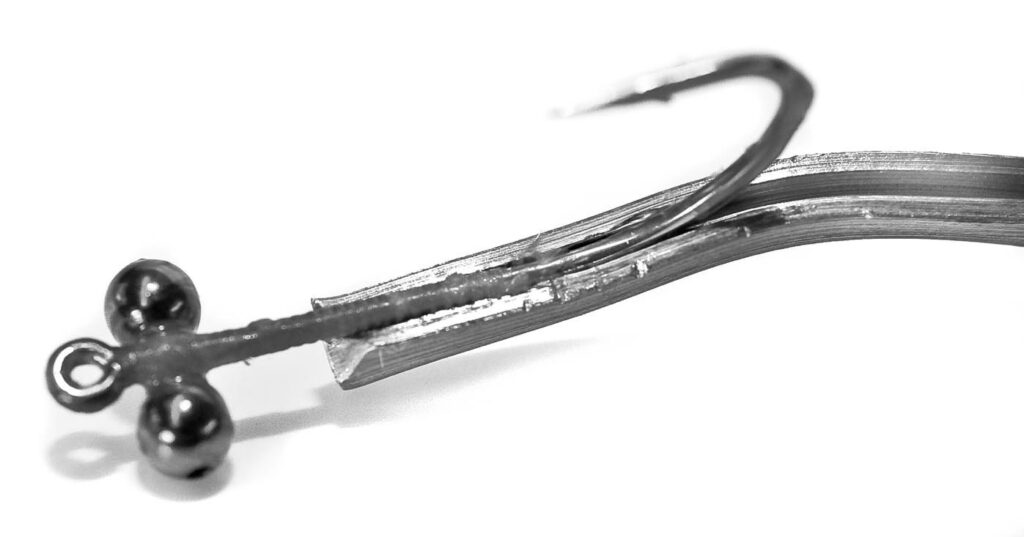
Abel’s new nipper got a lot of attention at last fall’s dealer show, and not only because the basic version costs $50. These nippers have been given some thought. They’re slim, so they don’t snag on your vest or pack, and their shape is easy to grip Bodies are anodized T6061-T6 aluminum for corrosion resistance. The pin and screws that hold things together are stainless steel. The replaceable jaws, of heat-treated stainless steel, are cut to handle both mono and braid, from 7X on up to 100-pound test. There’s a stainless steel lanyard ring at the hinge and a hook-cleaning pin behind the jaws. They’re available in eleven solid color finishes, and the fashionistas among us can order them anodized in any of Abel’s multiple fish-scale patterns for an upcharge of another $50.
For tyers and down-deep fly fishers, Cascade Crest Tools came up with something so obvious you have to wonder why it hasn’t been around forever: lead wire that’s extruded with a groove along its length. Tie it along the top of the hook shank, and the fly will ride point up, or to the bottom to make it ride point down. A heavier alternative to expensive scud weights, and easier to attach to hooks, Channel Lead is available in three sizes for hooks from size 2/0 to 14 at $4.25 for a three-quarter-ounce length. A useful trick in cutting the stuff, Pat Dunlap of Cascade Crest told me, is to use dog-nail clippers to avoid crushing the channel.
Finally, and earning my vote for the most useful goofy product, Orvis borrowed from the gardening industry to come up with their new Rubber Overshoes ($29.95). These are slip-on sandals of a closed-cell foam, about the size of a pair of small snowshoes, very light in weight, into which you simply slide your studded wading boots when you don’t want to grind up the deck of your friend’s drift boat or the floor of the café where you’re buying an emergency cheeseburger. A surprisingly nifty idea.







